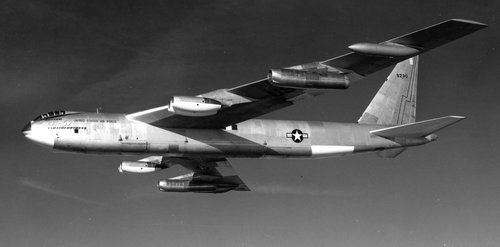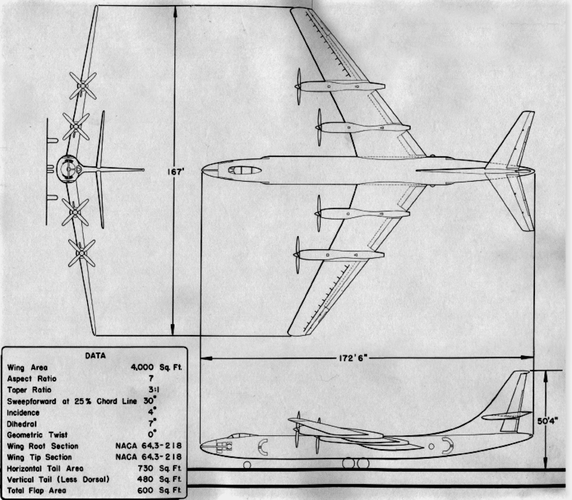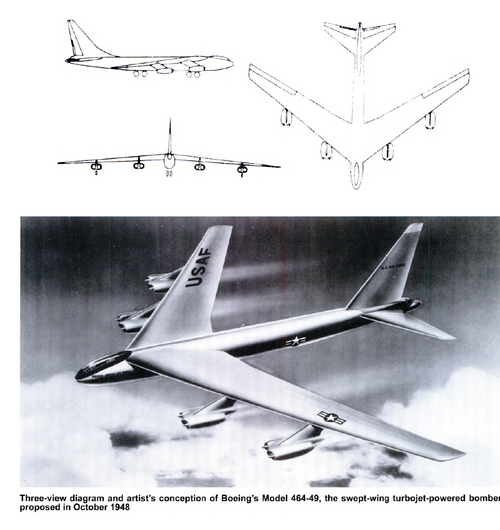Long-Range Heavy Bombardment Aircraft
In the summer of 1944, the US military came to the conclusion that it was necessary to create a new long-range bomber, which at the beginning of the next decade was to replace the existing Boeing B-29 Superfortress. In 1946 it was planned to consider the proposed projects and choose the best of them. By 1950, it was planned to build the first prototype of a prospective machine and begin its testing. It should be noted that the new bomber was supposed to replace not only the existing B-29, but also the Convair B-36 Peacemaker being developed at that time, as the military had already completely stopped working on this piston aircraft at the development stage.
In the fall of 1945, the US Air Force determined the requirements for a Long-Range Heavy Bomber. Taking into account the specifics of the development of air defense and fighter aircraft, the specialists of the Air Force considered that the new strategic aviation aircraft should have high, if not unique, characteristics for that time. To minimize the risk of destruction of the enemy by air defense, the aircraft had to accelerate to 725 km/h and fly at a cruising speed of about 560 km/h. The bomber had to climb to a height of 13,200 m. The working height was determined at 10670 m. The maximum payload was set at 36 tonnes. The maximum range of flight at 8 thousand km was to be achieved at a load of 4.5 tonnes.
During discussions with the participation of aviation industry specialists, the military realized that some specifications of the requirements were simply unattainable with the use of available technologies, units and assemblies. For this reason, a new version of the requirements appeared in a few months. Due to the lack of engines with reasonable fuel economy, the required maximum flight range was reduced. In addition, turbojet engines should now be used as a power plant, since turboprop engines could not provide the required flight data.
In the first half of 1946, at once three companies expressed their desire to participate in the program to create a long-range long-range bomber. Their variants of this aircraft were offered by Convair (Consolidated Vultee), Boeing and Martin. It is note-wrothy that all three proposed projects did not fully meet the requirements of the Air Force. Due to the lack of a number of necessary technologies and technical solutions, the maximum speed and range were less than those set, and the aircraft could not be operated from ground runways. Nevertheless, the military department has taken into consideration all the proposed projects.
The most interesting of the projects presented was that of the company Convair. In an attempt to create a long-range bomber with the required high performance, its designers decided to use a number of original and daring ideas that had not previously been used in developing such aircraft. The Long Range Heavy Bombardment Airplane project or LRHBA proposed to equip the new aircraft with a forward swept wing. For all the complexity of this design was to help achieve the required characteristics. The new project was to use some developments on a promising tactical strike aircraft with a wing of a similar design.
According to available data, the LRHBA project had one particularly interesting feature. When developing the preliminary version of the project, the goal was not to achieve the maximum possible characteristics at the level required by the technical task. Convair declared the requirements of the Air Force were overstated and unattainable with the modern development of the aviation industry. For this reason, the military was offered a variant of the aircraft, which could be built using existing technologies. In the future it was supposed to modernize the aircraft and gradually bring its characteristics to the required level.
There was a difference of opinion on the prerequisites for the appearance of a project with obviously understated characteristics. Convair feared for its B-36 project, the development of which was conducted at that time. A new program for the development of a long-range bomber threatened the B-36 project, which was of great financial interest to the company. Possibly Convair, not wanting to lose a profitable contract, deliberately promoted the idea of the impossibility of fulfilling the requirements of the customer, at least for the next several years. There is no acceptable evidence for such a version. All the documents speak about the problems with the technologies that complicated the development of the aircraft.
Despite the "conservatism" in terms of technology and materials, the LRHBA project was bold enough in other ways. With the use of industry opportunities in the mid-1940s, it was planned to build an aircraft with the possibilities for further modernization. In particular, initially the bomber had to be equipped with turboprop engines, and in the future they could be replaced with turbojet engines.
To achieve the maximum possible flight characteristics, the aircraft should have an appropriate aerodynamic shape. The design of the wing was developed taking into account the loads associated with the relatively large take-off weight, and also "sharpened" under the flight at maximum speeds. Studies have shown that flying at specified speeds without the risk of flow failure requires making a swept wing with a small relative thickness. The impossibility of achieving the required thickness and the absence of methods for controlling the flow failure led to the choice of a swept wing.
The Convair LRHBA proposed to the military was a high-flying normal aerodynamic scheme with a swept wing and a swept tail unit. To achieve the required range characteristics, a large fuel reserve was required, which affected the dimensions of the aircraft.
LRHBA obtained a wing with a sweep of -30 ° (along the ¼ chord line) in a span of 50.9 m. The wing area with an extension of 7 and a narrowing of 3: 1 was 372 sq.m. The wing had to be installed with a small angle of transverse V. On the wing were provided four large-length nacelles, smoothly conjugated with its surface. At the rear edge of the wing provided for advanced mechanization with flaps and ailerons.
The nose of the fuselage, 52.6 m long, housed a cockpit of pilots and navigators. In the middle part there were volumes for equipment and a cargo compartment for the transportation of bomb load. The crew of the proposed aircraft was to consist of 11 people: two pilots, a radio operator, a flight engineer, two navigator-bombardiers (one had to use a radar sight, the second was an optical sight) and five shooters. The crew was to be located in two cabins. In the nose were placed the seats of the entire crew, with the exception of a few gunners, for whom the tail cabin in the fuselage was intended in front of the keel. The cabins were connected by a long tube. In both cabins, cots were provided for the crew to rest during long flights.
Although the main defense of the new LRHBA aircraft was to be a high speed flight, Convair engineers did not forget about traditional defense equipment. In the side sponsors of the fuselage, which did not worsen the aerodynamics of the aircraft, it was proposed to install remotely controlled turrets with two automatic cannon of 20 mm caliber each. A similar installation was envisaged in the tail of the fuselage. Ammunition - 600 rounds per gun. The work of five turrets had to be controlled by five shooters, whose work stations provided remote control panels. The possibility of using gun turrets of traditional design was also considered.
To improve flight performance and improve control, the tail of the aircraft was made swept. The stabilizer was placed in the lower part of the keel. The arrow-shaped design of the keel and stabilizer made it possible to increase their efficiency in comparison with the feathering of another architecture and thereby improve the controllability of the aircraft in pitch and yaw.
The military demanded that the aircraft be able to operate from unimproved runways. In combination with the reverse sweep of the wing, this requirement seriously complicated the development of the chassis. The acceptable track of the chassis could be performed by installing the main stanchions on the wing, however this was due to certain problems. As a result, the main pillars were fixed on the front spar of the wing and made retractable into the fuselage. When developing the bow of the chassis, which had a traditional design, special problems did not arise.
Of great interest is the design of the nacelles of the prospective bomber. On the wing of the aircraft it was proposed to place four units with fairings protruding beyond the front and rear edges of the wing. In front of the gondola, in front of the wing edge, was the Wright T-35 turboprop engine. The engines had to be equipped with four-bladed propellers with variable pitch.
Four turboprop engines could not ensure the acceleration of the aircraft to the speeds specified in the terms of reference. For this reason, the LRHBA bomber had to have an additional power unit in the form of four General Electric TG-180 turbojet engines. Such engines placed in the rear of the nacelles. The air intakes of the engines were brought to the leading edge of the wing. Turboprop and turbojet engines had to work together on takeoff and, if necessary, accelerate to maximum speed. On cruising flight modes, only turboprop T-35s were proposed. According to calculations, the maximum speed of the aircraft (with the joint work of all eight engines) was to reach 650 km / h.
The Air Force's specification required the use of a bomb load weighing up to 36 tons. However, Convair engineers did not share the optimism of the military. The LRHBA could carry no more than 18 tons of bombs on board, but the recommended load was almost half that. The proposed aircraft project provided transportation of only 10 tons of bombs. With this load, the bomber could have acceptable flight data and maneuverability. The increase in load up to 18 tons was fraught with the risk of damage and destruction of the structure. The insufficiently strong fuselage could be deformed or destroyed under overloads of about 3 units, which greatly limited the maneuverability of the aircraft at high speeds.
The documents on the preliminary version of the LRHBA project offered several options for loading the bomber cargo compartment. Depending on the task, the aircraft could take on board as a multitude of bombs of small caliber, and one or two large. In addition, some options for combat load provided for the use of additional fuel tanks installed in the cargo compartment. Such tanks allowed to make the most effective use of available free volumes, not occupied by bombs.
Naturally, with the existing restrictions associated with the strength of the proposed aircraft, the fulfillment of the requirements of military speech did not go. There was a proposal to strengthen the central part of the fuselage, which allowed increasing the normal bomb load to 18 tons without losses in maneuverability, but such a revision of the project threatened to increase the take-off weight and reduce flight performance.
Despite the presence of many problems and inconsistency with the customer's requirements, the Long Range Heavy Bombardment Airplane project was still submitted to the military. The Air Force, having familiarized themselves with the documentation and calculations of the designers, accepted the project for consideration and did not exclude it from the program. Convair - in the event of receiving an appropriate order - promised to complete the development of the project and build a prototype aircraft before the end of the 1940s. In addition, it was planned to develop a new project that fully met the requirements of 1946.
Shortly after the end of the application for participation in the program, in the spring of 1946, the US War Department made its first conclusions. The Martin project called Model 236 did not suit the military and soon dropped out of the competition. In the future, only Boeing participated in the competition with the Model 462 project and Convair with the LRHBA.
The choice of the winner was very difficult. Both projects had their advantages and disadvantages. Each of the proposed aircraft outperformed the competitor in one characteristic and was inferior to it in others. Because of this, teh air Force had to choose not only the general figures of the calculated characteristics, but also a number of other parameters. At the end of May 1946, the Air Force decided. The Boeing Model 462 aircraft was inferior to the LRHBA bomber in some respects, but it was much cheaper and easier to manufacture and operate.
The Convair LRHBA project due to the refusal of the Air Force was terminated. Some of the developments in this project were subsequently used to create promising new models. The LRHBA project itself remained in the early stages of development. Since the military chose the project of another company, Convair did not even begin to build a model of the new bomber. The Long Range Heavy Bombardment Airplane remained just a set of drawings.
After that, Boeing continued developing its project, offering the military several new aircraft variants that had great differences from each other. In the end, in 1949, a project appeared Model 464-67, a radically designed 8-jet swpt-wing aircraft vastly changed from the original Model 462, a conservatively designed six-engine turboprop with a straight wing. In 1951, Boeing received an order to build a prototype and pre-series batch of bombers, now known as B-52.

























